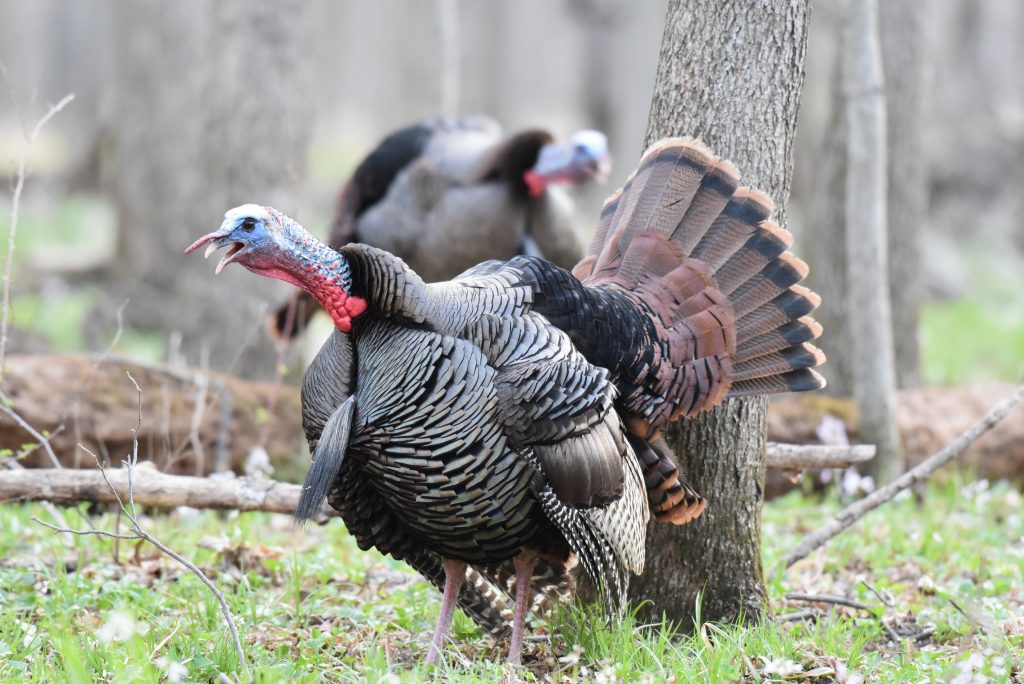Studying the Ecology of an Unhunted Turkey Population
Over 20 years after wildlife managers last trapped wild turkeys at SRS, researchers will trap these birds again. But, instead of being relocated to a different state or region, they will help inform wildlife managers and agencies on how to best frame hunting seasons and address regional declines witnessed in certain parts of the Southeast.
The NWTF is helping fund a new research project in South Carolina that seeks to inform hunting season frameworks and overall understanding of wild turkey ecology in the Palmetto State. Conducted by the University of Georgia, Louisiana State University, the USDA Forest Service and the South Carolina Department of Natural Resources, this novel research will examine movements, gobbling activity, nesting activity and habitat use in a wild turkey population devoid of turkey hunting.
“This project is unique in that we’re studying flocks of birds that are not subjected to hunting activity, hunting pressure or the harvest of males,” said Mike Chamberlain, Ph.D., Terrell Distinguished Professor of Wildlife Ecology at the University of Georgia. “Not only are we studying male behavior, but we’re extensively studying reproduction to see how nest success and brood survival on the site compares to the many hunted populations we’ve studied.”
The project will occur on the nearly 200,000-acre Savannah River Site, a Department of Energy-owned site in Aiken, Barnwell and Allendale counties. The rich medley of upland and bottomland hardwoods, mixed-pine hardwoods and planted stands of longleaf pine and loblolly pine, coupled with active forest management, provide the unhunted birds with exceptional habitat.
During the 1970s, while restoration efforts were in full effect, wildlife managers stocked this site to establish a large source population to assist trap-and-transfer efforts elsewhere. From the late 1970s to the early 2000s, almost 1,000 turkeys were trapped and relocated from SRS, a reference point for how strong the population was and continues to be to this day.
With exceptional wild turkey habitat, a robust existing population and virtually no hunting (except a very limited NWTF veterans hunt, which has not occurred in two years due to the Covid-19 pandemic), the area will provide a rare look into the life and times of an unhunted wild turkey population.
For each of the three years of the study, up to 40 females and 20 males will be aged, marked with an aluminum SCDNR leg band and equipped with a GPS-VHF radio transmitter. The transmitters will provide location points every hour during the day and one roost location each night. They will also be used to monitor and assess survival, movements, habitat use and more.
In addition to data collected from the transmitters, researchers will employ the use of acoustic recorders to monitor gobbling activity. Will gobblers on the project site be more vocal than hunted birds elsewhere? If so, when and how frequently? And how does that play into the turkey hunting season? This project seeks to answer these types of questions.

Researchers will compare the information they collect with similar data in hunted populations, which will help improve the overall understanding of how hunting affects how birds move, what types of habitat they select, what their survival rates are, when males gobble, when females nest and what types of vegetative structure hens prefer to nest in.
“It is an exciting time to be a turkey scientist,” said Bret Collier, Ph.D., associate professor of wildlife ecology at LSU. “There’s a lot of good science happening in our field that will inform how we best manage this beloved bird far into the future.”
Over 20 years after wildlife managers last trapped wild turkeys at SRS, researchers will trap these birds again. But, instead of being relocated to a different state or region, they will help inform wildlife managers and agencies on how to best frame hunting seasons and address regional declines witnessed in certain parts of the Southeast.
“Collectively, this work will assist agencies with understanding how wild turkeys function in the absence of hunting, which will help them better understand how harvest and harvest regulations can be best implemented to ensure sustainable populations through time,” Chamberlain said.
This project is one of seven new research projects the NWTF is funding. At the 12th National Wild Turkey Symposium, the NWTF announced its new $360,000 investment into wild turkey research.
In addition to the recent investment, the organization further illustrated the importance of research by committing to hold the 13th National Wild Turkey Symposium in 2025. The symposium is usually held every five years, but the NWTF is working to fast-track the meeting of researchers and managers to turn the tide of population declines.
